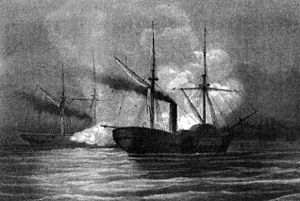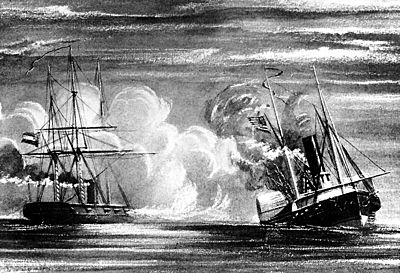USS Hatteras (1861) facts for kids

USS Hatteras in action with CSS Alabama, off Galveston, Texas, on 11 January 1863
|
|
| History | |
|---|---|
| Name | USS Hatteras |
| Namesake | An inlet on the coast of North Carolina |
| Builder | Harlan and Hollingsworth, Wilmington, Delaware |
| Laid down | date unknown |
| Launched | date unknown |
| Acquired | September 25, 1861 |
| Commissioned | October 1861 at the Philadelphia Navy Yard |
| Out of service | January 11, 1863 |
| Stricken | 1863 (est.) |
| Fate | Sunk in action, January 11, 1863 |
| Notes | formerly known as St. Mary |
| General characteristics | |
| Type | Steamer |
| Displacement | 1,126 long tons (1,144 t) |
| Length | 210 ft (64 m) |
| Beam | 18 ft (5.5 m) |
| Installed power | 500 ihp (370 kW) |
| Propulsion |
|
| Speed | 8 kn (9.2 mph; 15 km/h) |
| Complement | 126 |
| Armament | 4 × 32 pdr (15 kg) guns, 1 × 20 pdr (9.1 kg) gun |
|
USS Hatteras (41GV68)
|
|
| Location | Address restricted |
| Nearest city | Galveston, Texas |
| Area | less than one acre |
| NRHP reference No. | 77001567 |
| Added to NRHP | January 28, 1977 |
The USS Hatteras was a 1,126-ton iron-hulled steamer used by the Union Navy. It was bought at the start of the American Civil War. The ship was turned into a gunboat and helped with the Union blockade. This blockade aimed to stop trade in the ports and waterways of the Confederate States of America. During a battle with a disguised Confederate ship, the CSS Alabama, the Hatteras was surprised and sunk off Galveston, Texas. The wreck is now a special historical site. It is listed on the National Register of Historic Places. This is because it shows how ships changed from wooden sailing ships to steam-powered ones.
The Hatteras was first named St. Mary. The U.S. Navy bought it from Harlan and Hollingsworth in Wilmington, Delaware. This happened on September 25, 1861. The ship was prepared at the Philadelphia Navy Yard. It officially joined the Navy in October 1861. Commander George F. Emmons was its first captain.
Hatteras in the Civil War
The Hatteras sailed to Key West, Florida, on November 5, 1861. It arrived there on November 13. Its job was to join the South Atlantic Blockading Squadron. This group worked to cut off the South's trade. This was part of President Lincoln's Anaconda Plan. After blocking ports off Apalachicola, Florida, the Hatteras moved to Cedar Key, Florida. It got there on January 7, 1862.
Nine days later, the Hatteras launched a successful attack on Cedar Keys harbor. It burned seven small ships trying to break the blockade. These ships were full of turpentine and cotton. They were at the Florida Railroad wharf, an important Southern train station. The Hatteras also burned several flat-cars and buildings. To finish the day, the Hatteras captured 14 of the 22 soldiers stationed there. This included their leader. Attacks like these from the sea hurt the South a lot. They caused losses, stopped trade, and spread out their defenses.
After this mission, the Hatteras moved to the Gulf Blockading Squadron. It arrived off Berwick, Louisiana, on January 26. The next day, it fought the CSS Mobile. But it could not cause serious damage. The Mobile was a light ship and moved into shallow water.
Still, the Gulf of Mexico was a good place for the Hatteras. In less than a year, it captured seven ships trying to break the blockade. These ships carried cotton, sugar, and other goods. The South needed to sell these for gold or other goods. The Hatteras captured about 534 bales of valuable cotton. Commander Emmons even used one captured ship, the sloop Poody, as part of his own fleet. He renamed it Hatteras Jr..
Other Confederate ships captured by the Hatteras included the steamer Indian No. 2, schooner Magnolia, steamer Governor A. Mouton, schooner Sarah, sloop Elizabeth, and brig Josephine. Most of these ships were caught near Vermilion Bay, Louisiana. They were trying to reach Havana, Cuba, or the Sabine River area of Texas.
However, the Hatteras' successful time was cut short in early 1863. It was ordered to join the blockade fleet led by Rear Admiral David Farragut. Farragut was trying to take back the important Texas port of Galveston. Under its new captain, Commander Homer C. Blake, the Hatteras joined Farragut's group off Galveston on January 6, 1863.
Battle with the CSS Alabama
On the afternoon of January 11, 1863, the blockade fleet was near Galveston. Some sails were seen far away. The Hatteras was told to chase the unknown ship. It started chasing at about 3:00 PM. For the next four hours, it followed the ship closer to shore. As evening came, the Hatteras was close enough to talk to the ship. Commander Blake asked who they were. "Her Britannic Majaesty's Ship Petrel," came the answer. Blake was still suspicious. He ordered one of the Hatteras' small boats to check the "British" ship.

Just as the small boat left the Hatteras, a new answer rang out. "We are the CSS Alabama." With that, the famous Confederate ship, led by Raphael Semmes, lowered the Union Jack flag it had been flying. It then raised the Confederate Stars and Bars flag. The Alabama began firing its heavy cannons at the Hatteras. For about 20 minutes, in the dim light, the two ships fired at each other. They were very close, from 25–200 yd (23–183 m) apart. The flashes and sounds of the guns were heard by the Union fleet about 16 mi (26 km) away. The ship Brooklyn was sent to help if needed.
But the Hatteras was already badly hit in two places. It was on fire and starting to sink. Captain Blake ordered the gunpowder storage areas to be flooded. This was to stop an explosion. He sadly fired one gun, showing surrender and asking for help. The Alabama quickly sent its boats to rescue the Hatteras' crew and wounded. The last boatload of men had just left when the Union ship sank. This was about 45 minutes after the battle began.
Of the Hatteras' crew of 126, two sailors died and five were hurt. Six escaped back to the fleet in the boat that was first sent to check the "HMS Petrel". The rest, including Captain Blake, were taken to Port Royal, Jamaica. From there, they were sent back to the United States. The Alabama only had two wounded sailors.
When the Brooklyn reached the battle site the next morning, it found the Hatteras hull standing upright in the water. It was about 20 mi (32 km) south of Galveston Light. Only the Hatteras masts were sticking out of the water. From the highest mast, the U.S. Navy flag was still waving. Even after surrendering, the ship had not lowered its flag.
The Hatteras Today
The hull of the Hatteras rests in about 60 ft (18 m) of water. It is about 20 mi (32 km) off Galveston, Texas. It is buried under about 3 ft (0.91 m) of sand. Its steam engine and two iron paddle wheels are still on the ocean bottom. The wreck is watched to make sure it is not harmed by oil and gas work in the area.
The wreck of the Hatteras belongs to the United States Navy. However, the Texas Historical Commission, Texas A&M University at Galveston, and the federal Minerals Management Service (now Bureau of Ocean Energy Management) work together. They help protect this important historical site.
At one time, people looking for treasure tried to claim the right to salvage the ship. But the courts decided in favor of the United States government. This was one of the few times courts have chosen to protect a shipwreck site for history, rather than for commercial gain.
The Alabama Hills are named in honor of the CSS Alabama.

